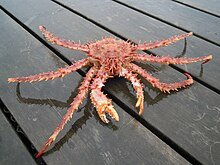Troll crabs, often overlooked in the vast marine ecosystem, are remarkable creatures that capture the imagination of those who take the time to learn about them. Known for their unique adaptations and intriguing behaviors, these crustaceans play an essential role in their habitats. This article dives into the captivating life of troll crabs, exploring their biology, habitat, behavior, and significance in our oceans.
What Are Troll Crabs?
Troll crabs belong to the family Oregoniidae, a group of marine crustaceans that thrive in the cold waters of the North Pacific. Unlike typical crabs, troll crabs possess distinctive features that set them apart.
- Physical Characteristics:
- They have a broad, flattened body with long, spindly legs.
- Their claws are typically large and robust, adapted for scavenging and feeding.
- The carapace is usually covered in tiny hairs, providing them with a fuzzy appearance.
The Habitat of Troll Crabs
Troll crabs primarily inhabit the rocky substrates of the North Pacific, particularly around the coasts of Alaska and British Columbia.
Preferred Environments
- Rocky Shores: Troll crabs love rocky areas to hide from predators and find food.
- Deep Waters: These crabs are often found at depths ranging from 30 to 300 meters (98 to 984 feet), where they forage for food and shelter.
- Cold Temperatures: They thrive in calmer waters, making the Pacific Northwest an ideal habitat.
The Diet of Troll Crabs
Troll crabs are omnivores, meaning they eat both plant and animal matter. Their diet consists of:
- Algae: They graze on various types of algae found on rocks.
- Detritus: Dead organic matter plays a significant role in their diet as they scavenge for nutrients.
- Small Invertebrates also hunt smaller marine organisms, such as shrimp and mollusks.
Unique Adaptations of Troll Crabs
One of the most fascinating aspects of troll crabs is their unique adaptations, which help them survive in their environment.
Camouflage
Troll crabs have developed excellent camouflage skills. Their fuzzy carapace can blend seamlessly with their surroundings, making it difficult for predators to spot them. This ability to remain hidden is crucial for their survival.
Claw Strength
The large claws of troll crabs are not just for show; they are potent tools for foraging and defending against threats. With these claws, they can pry open the shells of mollusks or fend off potential predators.
Behavior
Troll crabs exhibit exciting behaviors that enhance their chances of survival.
- Foraging Techniques: They often forage at night, which helps them avoid many predators.
- Social Interactions: Troll crabs can often be found in groups, which offers protection and increased foraging success.
The Lifecycle of Troll Crabs
Understanding the lifecycle of troll crabs adds another layer to their complexity.
Reproduction
Troll crabs have a fascinating reproductive process:
- Mating Season: Mating typically occurs in the spring.
- Egg Development: After mating, females carry their eggs under their bodies until they hatch, usually taking about a month.
- Larval Stage: Once hatched, the larvae drift in the ocean currents for several weeks before settling down and developing into juvenile crabs.
Growth Stages
As troll crabs grow, they go through several molting stages. Each molting allows them to grow larger and shed their exoskeleton, vital for their development.
The Importance of Troll Crabs in Their Ecosystem
Troll crabs play a significant role in their ecosystem, contributing to the health and balance of their marine environments.
Nutrient Cycling
By feeding on detritus and other organic matter, troll crabs help recycle nutrients into the ecosystem. This process is crucial for the growth of algae and other marine plants, which serve as the base of the food chain.
Prey and Predator Relationships
Troll crabs are both predators and prey in their environment. They help control populations of smaller invertebrates while serving as a food source for larger predators, such as fish and seabirds.
Conservation Status of Troll Crabs
The conservation status of troll crabs is essential as environmental changes impact their habitats.
Threats
- Overfishing: Increased fishing pressure can lead to declines in troll crab populations.
- Habitat Destruction: Coastal development and pollution threaten the rocky habitats that troll crabs depend on.
Conservation Efforts
Efforts are being made to protect troll crab habitats and promote sustainable fishing practices. These initiatives aim to ensure that future generations can appreciate and study these remarkable creatures.
Fascinating Facts About Troll Crabs
Here are some fun and exciting facts about troll crabs that you might not know:
- Not Just a Name: The name “troll crab” doesn’t come from their behavior but rather from their habitat—often found in areas where trolling (a fishing technique) occurs.
- Life Span: Troll crabs can live up to 20 years in the wild under the right conditions.
- Color Variations: While many troll crabs are brown or green, some exhibit vibrant colors, which vary based on their environment.
Conclusion
Troll crabs are fascinating creatures that play a crucial role in marine ecosystems. With their unique adaptations, complex behaviors, and importance in nutrient cycling, these crabs deserve more recognition and study. As we learn more about troll crabs, we can better appreciate the intricacies of marine life and the need to protect their habitats for future generations.
So, the next time you hear about a troll crab, remember their vital contributions to our oceans and the incredible adaptations that allow them to thrive in their environment. Let’s work together to preserve troll crabs and their habitats for years.
